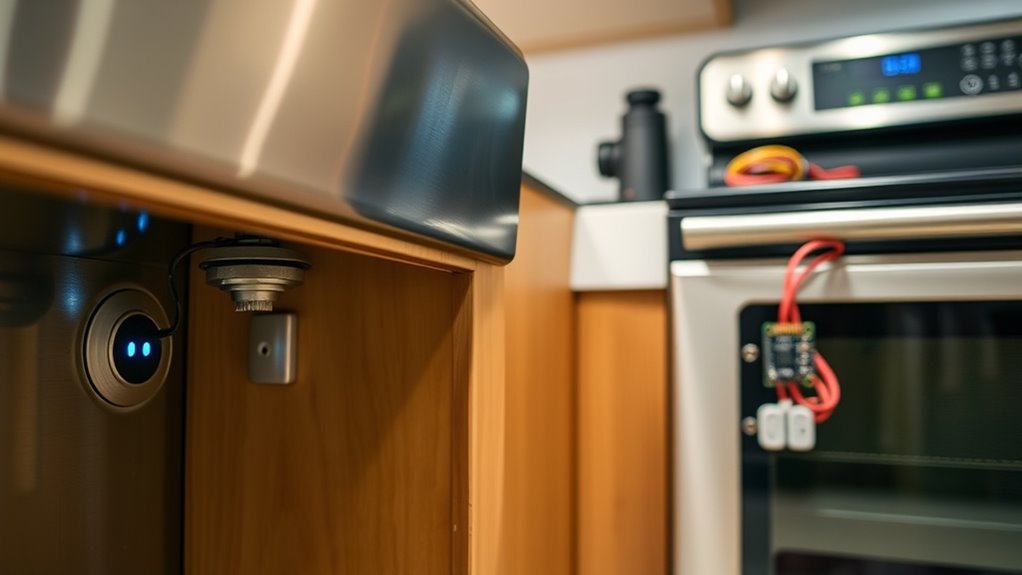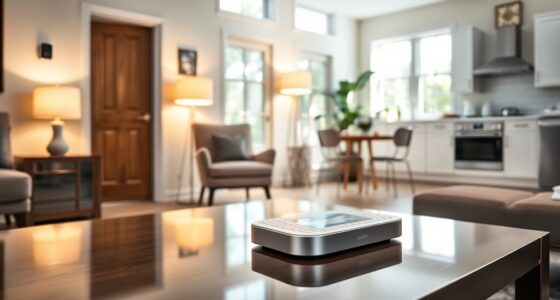Installing DIY sensors for your doors, stoves, and water alerts is an affordable way to boost your home’s safety and security. You can use magnetic switches for door sensors, thermistors or infrared sensors for heat detection, and water probes for leak detection—all connected to microcontrollers like Arduino or Raspberry Pi. These simple upgrades help prevent accidents and unauthorized entries without breaking the bank. Keep exploring to discover how to customize and maximize your smart home safety system.
Key Takeaways
- DIY door sensors using magnets and reed switches provide affordable home security and instant alerts.
- Heat sensors with thermistors or infrared modules help monitor stove or oven temperatures for safety.
- Water level and leak detection with conductive probes prevent flooding in basements or laundry areas.
- Integration of microcontrollers enables customized alerts and automation for enhanced safety measures.
- Building these sensors is cost-effective, easy, and customizable, offering significant safety and security benefits.

Have you ever wanted to create your own sensors for a project but thought it was too complicated? The good news is, building simple sensors isn’t as difficult as it might seem, and the payoff can be significant. Whether you’re aiming to improve home security, automate appliances, or monitor water usage, DIY sensors can give you more control and peace of mind without breaking the bank. The key is understanding basic components and how to connect them effectively.
Start with a door sensor—one of the easiest projects to tackle. All you need is a simple magnetic switch or reed relay. When the door opens, the magnetic field is disrupted, triggering a change in the circuit. You can connect this to a microcontroller like Arduino or Raspberry Pi, which detects the change and sends alerts via Wi-Fi or SMS. Setting this up is straightforward: attach a magnet and switch to the door frame and door, connect the switch to your microcontroller, and program it to notify you if the door opens unexpectedly. This DIY sensor can act as an affordable security measure, alerting you instantly if someone enters when they shouldn’t.
Build an easy door sensor with a magnet, reed switch, and microcontroller for instant alerts.
Similarly, creating a stove or oven heat sensor can be surprisingly simple. Using a thermistor or an infrared sensor, you can monitor temperature levels. Connect the sensor to a microcontroller, and program it to send a notification if the temperature exceeds a safe threshold. This setup helps prevent accidents, especially if you tend to forget about cooking or are away from home. Plus, it can be integrated into a broader home automation system, giving you real-time updates on your stove’s status. All it takes is a basic understanding of how to wire a thermistor and some simple coding to make your kitchen smarter and safer.
Understanding sensor integration is essential for creating reliable and effective DIY projects, enabling you to customize your alerts and automation systems to better suit your needs.
Water alerts are another practical DIY project. You can use a simple water level sensor or a conductive probe made from two metal wires. When water reaches a certain level, it completes the circuit, triggering an alert. Connecting this to a microcontroller allows you to receive notifications if, for example, your sump pump fails or if a leak occurs. These sensors are especially useful for basements, laundry rooms, or anywhere water damage could be costly. They’re inexpensive, easy to assemble, and can be customized to suit your specific needs.
Frequently Asked Questions
What Are the Best Sensor Brands for DIY Home Projects?
You should consider brands like Raspberry Pi, Arduino, and Xiaomi for your DIY home projects. These brands offer reliable, versatile sensors that are easy to integrate and customize. Raspberry Pi and Arduino provide extensive support and community resources, making troubleshooting simple. Xiaomi sensors are affordable and user-friendly, perfect for quick setups. Whichever you choose, guarantee it fits your specific needs for security, safety, or automation.
How Much Do DIY Sensors Typically Cost to Install?
On average, DIY sensors cost between $20 and $100 to install, depending on the type and complexity. Notably, a study shows that homeowners save up to 30% on energy bills after installing smart sensors. You can often set up these devices yourself, saving labor costs. Basic door or water leak sensors are affordable and simple, while more advanced systems might need extra components, but overall, DIY installation is budget-friendly.
Can DIY Sensors Integrate With Existing Smart Home Systems?
Yes, DIY sensors can often integrate with your existing smart home systems. Many sensors are compatible with popular platforms like Alexa, Google Home, or Apple HomeKit, allowing seamless control and automation. Check the sensor specifications and your system’s compatibility before purchasing. You might need a hub or a compatible app, but generally, DIY sensors are designed to connect easily, giving you more control and smarter automation in your home.
What Maintenance Is Required for DIY Sensors Over Time?
You’ll need to regularly check your DIY sensors to guarantee they’re functioning properly. Replace batteries as needed, typically every few months, and keep the sensors clean to prevent dust or debris from interfering. Update software or firmware when updates are available to fix bugs and improve performance. Also, periodically test the sensors to confirm they send alerts correctly and make adjustments if you notice any issues.
Are DIY Sensors Reliable Enough for Critical Safety Alerts?
DIY sensors can be reliable for safety alerts if you choose quality components and follow proper installation procedures. Regularly testing and maintaining your sensors ensures they function correctly when needed. Keep firmware updated and check connections periodically. While they may not match commercial systems in sophistication, well-made DIY sensors can effectively alert you to hazards, provided you stay vigilant with their upkeep and understand their limitations.
Conclusion
By building your own sensors for doors, stoves, and water leaks, you’re not just saving money—you’re gaining peace of mind. These DIY projects put control back in your hands, making your home smarter and safer. Think of it like having a modern-day butler, alerting you before a disaster strikes. With a little effort, you can turn your humble abode into a fortress of safety, proving that sometimes, the simplest ideas are the most powerful.









